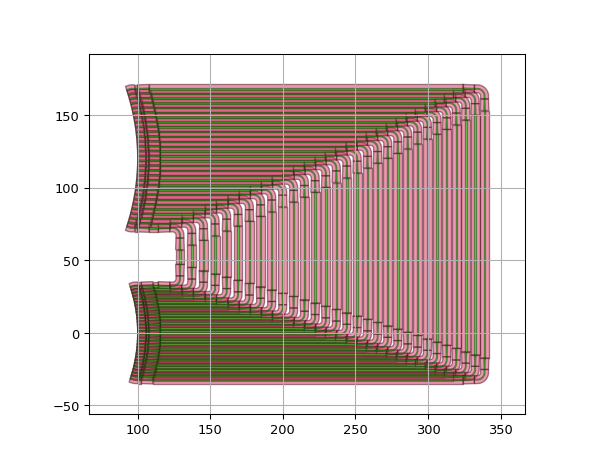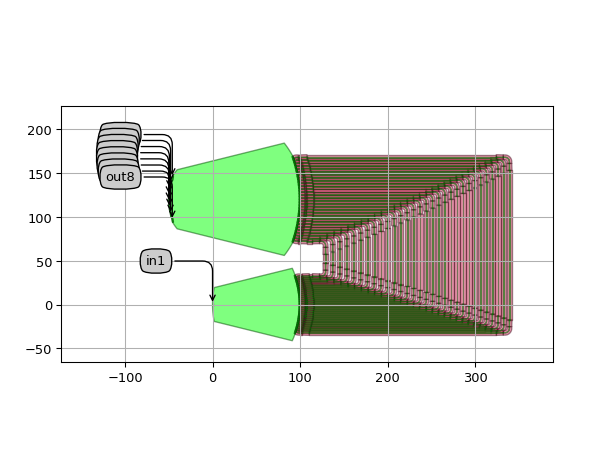RectangularTaperedWaveguideArray
- class awg_designer.all.RectangularTaperedWaveguideArray
U-shaped rectangular bundle of tapered waveguides. Similar to RectangularWaveguideArray but allows to flare out the waveguides in the straight sections.
This array of waveguides implements the delays in the AWG using a U-shaped waveguide bundle. In the straight sections, a broader waveguide can be used (
straight_trace_template) to reduce loss and phase errors.- Parameters:
- start_ports: PortList, required
Ports that define the starting position, the angle, and the trace template for each waveguide in the array.
- delay_lengths: list, required
Delay lengths to implement in the arms
- end_ports: ( PortList ), *None allowed*
Ports that define the relative ending position, the angle, and the trace template for each waveguide in the array. Only the distances between the neighboring ports are used, as the waveguide array decides how large the array has to be in order to meet the specifications. It then translates the output accordingly. When None, assume these are the same as start_ports.
- straight_trace_template: PCell and _WaveguideTemplate
Waveguide template for the expanded waveguides used in the straight sections.
- name: String that contains only ISO/IEC 8859-1 (extended ASCII py3) or pure ASCII (py2) characters
The unique name of the pcell
- Other Parameters:
- trace_template: PCell and _WaveguideTemplate, locked
Waveguide template to use for drawing the bundles. Derived from the reference ports.
Views
- class Layout
- Parameters:
- fanout_route_properties: dict
Default fanout route parameters (min_straight, start_straight, end_straight).Bend_radius and rounding_algorithm are set to be the same as for the other routes (in the waveguide array).
- route_properties: dict
Route properties for the waveguide array (bend_radius, rounding_algorithm, angle_stepmin_straight, start_straight, end_straight). If empty, use default values from the technology.
- cover_layers:
layers to cover the waveguide bundle with
- bundle_spacing: float and int, float, integer, floating and number >= 0
Spacing between the upper and bottom parts of the array
- taper_length: ( float and number > 0 ), *None allowed*
Length of the taper between the regular waveguide and the expanded waveguide. If
None, the default taper lengths for each transition are calculated.- view_name: String that contains only alphanumeric characters from the ASCII set or contains _$. ASCII set is extended on PY3.
The name of the view
Examples
import si_fab.all as pdk # noqa: F401 import ipkiss3.all as i3 import awg_designer.all as awg import numpy as np from picazzo3.traces.wire_wg.trace import WireWaveguideTemplate slab_t = awg.SlabTemplate() slab_t.Layout(slab_layers=[i3.TECH.PPLAYER.SI]) num_arms = 44 # number of arms radius = 150.0 # radius of the star couplers width = 2.0 # aperture width # Make virtual aperture ap = awg.OpenWireWgAperture(slab_template=slab_t) ap.Layout(aperture_core_width=width, aperture_edge_width=1.0) # Make a multi-aperture for the arms consisting of num_arms apertures like these, arranged in a circle angle_step = i3.RAD2DEG * (width + 0.2) / radius angles_arms = np.linspace(-angle_step * (num_arms - 1) / 2.0, angle_step * (num_arms - 1) / 2.0, num_arms) ap_arms_in, _, trans_arms_in, trans_ports_in = awg.get_star_coupler_apertures( apertures_arms=[ap] * num_arms, apertures_ports=[ap], angles_arms=angles_arms, angles_ports=[0], radius=radius, mounting="confocal", input=True, ) # Make the input star coupler sc_in = awg.StarCoupler(aperture_in=ap, aperture_out=ap_arms_in) sc_in_lo = sc_in.Layout( contour=awg.get_star_coupler_extended_contour( apertures_in=[ap], apertures_out=[ap] * num_arms, trans_in=trans_ports_in, trans_out=trans_arms_in, radius_in=radius, radius_out=radius, extension_angles=(10, 5), ) ) # bundle parameters delay = 10 delay_lengths = [delay * i for i in range(num_arms)] bundle_spacing = 100 route_properties = { "min_straight": 2.0, "start_straight": 1.0, "end_straight": 1.0, "bend_radius": 5.0, "rounding_algorithm": i3.ShapeRound, "angle_step": 1.0, } straight_trace_template = WireWaveguideTemplate() straight_trace_template.Layout(core_width=1.0, cladding_width=3.0) wg_array = awg.RectangularTaperedWaveguideArray( start_ports=sc_in_lo.east_ports, delay_lengths=delay_lengths, straight_trace_template=straight_trace_template, ) wg_array_lo = wg_array.Layout( taper_length=10.0, bundle_spacing=bundle_spacing, # spacing of the input and the output ports route_properties=route_properties, cover_layers=[i3.TECH.PPLAYER.NONE], ) wg_array_lo.visualize()

import si_fab.all as pdk # noqa: F401 from ipkiss3 import all as i3 import numpy import awg_designer.all as awg slab_t = awg.SlabTemplate() slab_t.Layout(slab_layers=[i3.TECH.PPLAYER.SI]) N = 30 # number of arms R = 100.0 # radius of the star couplers W = 2.0 # aperture width M = 8 # outputs # Make a virtual aperture ap = awg.OpenWireWgAperture(slab_template=slab_t) ap.Layout(aperture_core_width=W, aperture_edge_width=1.0) angle_step = i3.RAD2DEG * (W + 0.2) / R angles_arms = numpy.linspace(-angle_step * (N - 1) / 2.0, angle_step * (N - 1) / 2.0, N) ap_arms_in, _, trans_arms_in, trans_ports_in = awg.get_star_coupler_apertures( apertures_arms=[ap] * N, apertures_ports=[ap], angles_arms=angles_arms, angles_ports=[0], radius=R, mounting="confocal", input=True, ) # Make the input star coupler sc_in = awg.StarCoupler(aperture_in=ap, aperture_out=ap_arms_in) sc_in_lo = sc_in.Layout( contour=awg.get_star_coupler_extended_contour( apertures_in=[ap], apertures_out=[ap] * N, trans_in=trans_ports_in, trans_out=trans_arms_in, radius_in=R, radius_out=R, extension_angles=(10, 5), ) ) # Make the multi-apertures for the outputs and get the transformations for the individual apertures. angle_step = i3.RAD2DEG * 4.7 / R angles_ports = numpy.linspace(angle_step * (M - 1) / 2.0, -angle_step * (M - 1) / 2.0, M) ap_arms_out, ap_out, trans_arms_out, trans_ports_out = awg.get_star_coupler_apertures( apertures_arms=[ap] * N, apertures_ports=[ap] * M, angles_arms=angles_arms, angles_ports=angles_ports, radius=1.5 * R, mounting="rowland", input=False, ) # Make the output star coupler sc_out = awg.StarCoupler(aperture_in=ap_arms_out, aperture_out=ap_out) sc_out_lo = sc_out.Layout( contour=awg.get_star_coupler_extended_contour( apertures_in=[ap] * N, apertures_out=[ap] * M, trans_in=trans_arms_out, trans_out=trans_ports_out, radius_in=R, radius_out=R / 2, extension_angles=(10, 10), ) ) delays = [20.0 * i for i in range(N)] start_ports = [port for port in sc_in_lo.ports.y_sorted() if "out" in port.name] end_ports = [ port for port in i3.SRef(reference=sc_out_lo, transformation=i3.Rotation(rotation=180)).ports if "in" in port.name ] # Make a tapered rectangular waveguide array expanded_tt = pdk.SiWireWaveguideTemplate() expanded_tt.Layout(core_width=1.0) waveguide_array_exp = awg.RectangularTaperedWaveguideArray( start_ports=start_ports, end_ports=end_ports, delay_lengths=delays, straight_trace_template=expanded_tt ) wgarr_exp_lo = waveguide_array_exp.Layout(bundle_spacing=40) wgarr_exp_lo.visualize() # Plot the full awg: rect_awg_exp = awg.ArrayedWaveguideGrating( star_coupler_in=sc_in, star_coupler_out=sc_out, waveguide_array=waveguide_array_exp ) awg_exp_lo = rect_awg_exp.Layout() awg_exp_lo.visualize(annotate=True)

